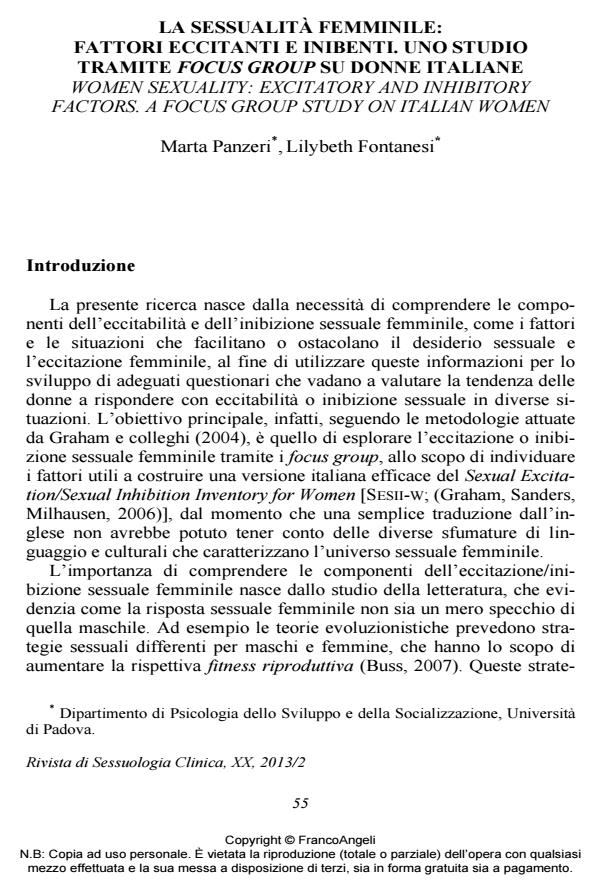La sessualità femminile: fattori eccitanti e inibenti. Uno studio tramite focus group su donne italiane
Titolo Rivista RIVISTA DI SESSUOLOGIA CLINICA
Autori/Curatori Marta Panzeri, Lilybeth Fontanesi
Anno di pubblicazione 2013 Fascicolo 2013/2
Lingua Italiano Numero pagine 18 P. 55-72 Dimensione file 364 KB
DOI 10.3280/RSC2013-002003
Il DOI è il codice a barre della proprietà intellettuale: per saperne di più
clicca qui
Qui sotto puoi vedere in anteprima la prima pagina di questo articolo.
Se questo articolo ti interessa, lo puoi acquistare (e scaricare in formato pdf) seguendo le facili indicazioni per acquistare il download credit. Acquista Download Credits per scaricare questo Articolo in formato PDF

FrancoAngeli è membro della Publishers International Linking Association, Inc (PILA)associazione indipendente e non profit per facilitare (attraverso i servizi tecnologici implementati da CrossRef.org) l’accesso degli studiosi ai contenuti digitali nelle pubblicazioni professionali e scientifiche
L’obiettivo della presente ricerca è quello di comprendere le componenti del desiderio sessuale femminile, individuando quei fattori, psicologici, emozionali, situazionali o adattivi, che influenzano l’eccitazione femminile. Sono stati condotti 15 focus group, a cui hanno partecipato 114 donne (età media = 30 anni, gamma = 18-76 anni). Le partecipanti hanno descritto l’eccitazione sessuale attraverso fattori sia fisiologici (come la lubrificazione vaginale) che emozionali, psicologici e comportamentali. La relazione tra desiderio ed eccitazione è complessa: secondo alcune, il desiderio precede l’eccitazione sessuale, mentre per altre le due fasi avvengono contemporaneamente. Dai risultati emerge una vasta gamma di fattori che inibiscono o aumentano l’eccitazione sessuale, riguardanti se stesse (come l’essere a disagio con il proprio corpo o il provare vergogna), il partner (come la mancanza di complicità o aspetti prettamente fisici del partner) e la situazione. Questi risultati oltre a migliorare la comprensione del desiderio, possono essere utili per la costruzione di questionari che indaghino la sessualità femminile.;
Keywords:Sessualità femminile, eccitazione, inibizione, desiderio, focus group, fattori adattivi.
- Albanesi C. (2004). I Focus group. Roma: Carocci.
- Bancroft J., Janssen E. (2000). The dual control model of a male sexual response: a theoretical approach to centrally mediated Erectile dysfunction. Neuroscience and Biobehavioral Review, 24: 571-9. DOI: 10.1016/S0149-7634(00)00024-5
- Basson R. (2000). The female sexual response: a different model. Journal of Sex & Marital Therapy, 26: 51-65. DOI: 10.1080/009262300278641
- Buss D. M. (2004). Evolutionary psychology. New York: Allyn & Bacon.
- Buss, D. M. (2007). The evolution of human mating. Acta Psychologica Sinica, 39: 502-12. DOI: 10.1037/0022-3514.54.4.616
- Buss D.M. (2012). Evolutionary psychology: the new science of the mind, IV Edition. Pearson Education (trad. it: Psicologia evoluzionistica. Milano: Pearson Italia).
- Buss D.M., Schmitt D.P. (1993). Sexual strategies theory: an evolutionary perspective on human mating. Psychological Review, 100: 204-32. DOI: 10.1037/0033-295X.100.2.204
- Ellis B.J., Symons D. (1990). Sex differences in sexual fantasy: an evolutionary psychological approach. Journal of Sex Research, 27: 527-55. DOI: 10.1080/00224499009551579
- Gangestad S.W. (1993). Sexual selection and physical attractiveness. Human Nature, 4: 205-35. DOI: 10.1007/BF02692200
- Graham C.A., Sanders S.A., Milhausen R.R. (2006). The sexual excitation/sexual inhibition inventory for women: psychometric properties. Archives of Sexual Behavior, 35, 4: 397-09. DOI: 10.1007/s10508-006-9041-7
- Graham C.A., Sanders S.A., Milhausen R.R., Mcbride M.A. (2004). Turning on and turning off: A focus group study of the factors that affect women’s sexual arousal. Archives of Sexual Behavior, 33: 527-38. DOI: 10.1023/B:ASEB.0000044737.62561.fd
- Knoth R., Boyd K., Singer B. (1988). Empirical tests of sexual selection theory: predictions of sex differences in onset, intensity, and time course of sexual arousal. The Journal of Sex Research, 24:73-89. DOI: 10.1080/00224498809551399
- Miller G.F. (1998). How mate choice shaped human nature: a review of sexual selection and human evolution. In: Crawford C. e Krebs D., eds., Handbook of evolutionary psychology: ideas, issues, and applications. Mahwah, NJ: Lawrence Erlbaum.
- Morgan D.L. (1997). Focus groups as qualitative research. Thousand Oaks, CA: Sage.
- Simpson J.A., Gangestad S.W. (1992). Sociosexuality and romantic partner choice. Journal of Personality, 60: 31-52. DOI: 10.1111/j.1467-6494.1992.tb00264.x
- Sprecher S., Regan P.C. (1996). College virgins: how men and women perceive their sexual status. The Journal of Sex Research, 33: 3-15. DOI: 10.1080/00224499609551810
- Taylor J.F., Rosen R.C., Leiblum S.R. (1994). Self-report assessment of female sexual functioning: psychometric evaluation of the brief index of sexual functioning for women. Archives of Sexual Behavior, 23: 627-643. DOI: 10.1007/BF01541816
- Validation of the Sexual Inhibition/Sexual Excitation Scales (SIS/SES) in Italy: Assessing Gender and Age Differences of Sexual Functioning Marta Panzeri, Harold Dadomo, Lucia Ronconi, Lilybeth Fontanesi, in Archives of Sexual Behavior /2021 pp.2755
DOI: 10.1007/s10508-021-01972-3
Marta Panzeri, Lilybeth Fontanesi, La sessualità femminile: fattori eccitanti e inibenti. Uno studio tramite focus group su donne italiane in "RIVISTA DI SESSUOLOGIA CLINICA" 2/2013, pp 55-72, DOI: 10.3280/RSC2013-002003